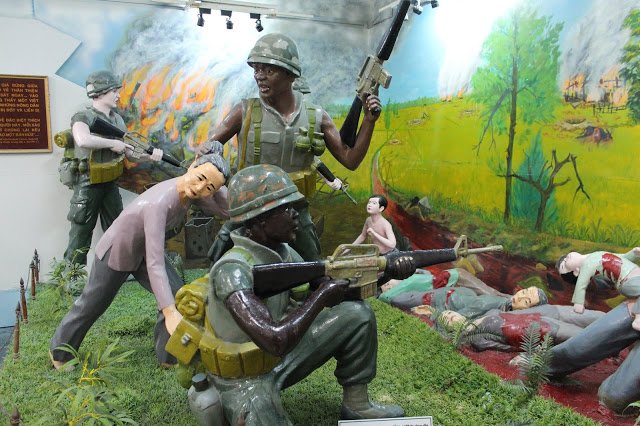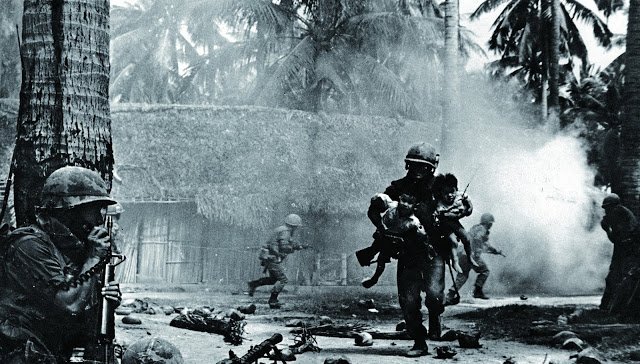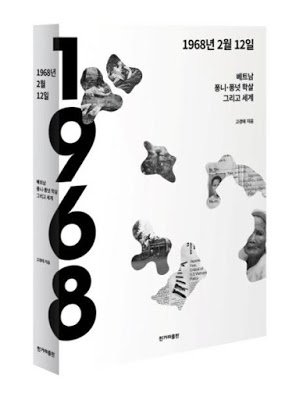Precursor to the Mỹ Lai Massacre: 1968 Phong Nhị, Phong Nhất_#1
Chapter 1: Three Trivia Questions
If you are 50 years or older yet cannot answer this question immediately, you are likely to be criticized for not knowing about an event that was so famous worldwide. On the other hand, if you are close to or in your 20s, and are able to answer correctly, kudos to you; you have a fairly good grasp of history.
Question 1: The Mỹ Lai Massacre is related to which of the following wars?:
- The Second Sino-Japanese War
- The Korean War
- The Vietnam War
- The Iraq War
Mỹ Lai is a classic case of war crimes and genocide, whereby in a matter of a single day, 347(at a minimum) to 504 civilians of the same village were annihilated by soldiers. Most of the victims were helpless children, women, and the elderly. The massacre took place on March 16, 1968, but it wasn’t until well into the following year, on November 12, 1969, that the event was made known to the rest of the world. Seymour Hersh, an American investigative journalist, interviewed U.S. soldiers and became the first to unveil the matter through AP (Associated Press). The New York Times, Time, and Life, among others, followed suit in covering the issue, and soon the massacre began appearing both in print and on screen worldwide.
Let’s take a look at the answer options:
1) The Second Sino-Japanese War was during the 1930s, the similarly horrid Nanking Massacre taking place in 1937.
2) The Korean War was during the 1950s, with the No Gun Ri Massacre occuring a day after the outbreak of war.
4) The Iraq War, during which the Haditha Massacre took place, was in the early 2000s.
The correct answer is: 3) The Vietnam War
The United States became directly involved in the war in August of 1964, claiming that the U.S. Navy destroyer Maddox was attacked by a Northern Vietnamese torpedo boat in the Gulf of Tonkin. The war reached its peak in 1968; just in the first two months of the year, the Battle of Khe Sahn and the Tet Offensive left South Vietnam in a bloodbath. The U.S. did achieve victory, and barely at that, but the casualties offset any sense of triumph. In the following month of March, the Mỹ Lai Massacre broke out, inflicted by the U.S. Army.
“Mỹ Lai” was the name used on the U.S. Army’s operation map; The actual name of the village where the massacre took place is “So’n Mỹ”--a small village located in the Sơn Tịnh District of Quang Ngai Province, which was under the jurisdiction of the South Vietnamese government. On the day of the massacre, the U.S. Army Charlie Company, 1st Battalion, 11th Brigade, 23rd Infantry Division, blindly fired M16 rifles and and M60 machine guns at the unarmed civilians and threw hand grenades into their air-raid shelters, setting each house ablaze. It was a day of mass-murder frenzy. There was no legitimate reason to view the civilians, who consisted mostly of the elderly, women and children, as targets for annihilation. The U.S. soldiers, who a few days ago had lost five of their men to booby traps, were venting their anger on those who had nothing to do with their loss.

My Lai Museum located in the Sơn Tịnh District of Quang Ngai Province, Vietnam. Sculptures displaying U.S. troops massacring the villagers of Son My. (Photo by humank; Jan 2016)
Now let’s try another history trivia:
Question 2: Which of the following wars is the Phong Nhị and Phong Nhất Massacre related to?
- The Second Sino-Japanese War
- The Korean War
- The Vietnam War
- The Iraq War.
This one might be a bit more elusive, given that unlike “Mỹ Lai,” neither “Phong Nhị” nor “Phong Nhất” is a name we hear commonly. If you, the reader, regardless of your age, were able to easily answer the question above, not only are you quite the history buff, but you are also very likely interested in war crimes and issues pertaining to human rights.
The correct answer to the question is the same as the answer to the question above. It is the Vietnam War.
However, the difference is that the Phong Nhị and Phong Nhất Massacre wasn’t perpetrated by the U.S. army, but by their allied forces, the South Korean Marine Corps. Furthermore, this massacre, which took place on February 12, preceded the Mỹ Lai Massacre by a month.
Phong Nhị and Phong Nhất are small adjacent rural villages within the Điện Bàn District of Quang Nam province, located 140 km north of So’n Mỹ, where the Mỹ Lai Massacre took place. The villages are situated between Da Nang (where the U.S. III Marine Amphibious Force Headquarters and Airbase were located) and the historical city of Hội An, with a radius of roughly 20km to each city. A group of South Korean Marines ravaged these two villages, murdering en masse a combined total of 74 civilians.
On January 31, 1968, the North Vietnamese Army (NVA) and the National Liberation Front (also known as the Việt Cộng) took over the U.S. Embassy in South Vietnam’s then capital, Saigon (now Ho Chi Minh City) and incited an uprising in all of South Vietnam in what was to be remembered as the Tet Offensive. Just three days ago, 4,800 troops of the 2nd ROK (South Korean) Marine Brigade had relocated their base entirely to Hội An and its neighboring areas. These troops, who were now planning a counterattack to the Tet Offensive in the Điện Bàn District (which encompassed the villages of Phong Nhị and Phong Nhất), or Quang Nam province at large, would eventually rise to fame for their unspeakable atrocities.
The ROK Army sent combat troops to South Vietnam from 1965 to 1972, annually stationing roughly 50,000 troops (the total number during those eight years being 320,000). U.S. President Lyndon B. Johnson, under his “Many Flags” initiative, requested that more of its allies dispatch combat troops to South Vietnam but wasn’t able to elicit the kind of excitement and ensuing support he had hoped for. Even the closest allies of the U.S. at the time, England and France, refused to comply. South Korea, however, was wholeheartedly willing to adhere to the requests of the United States.
Although the ROK Army presence was only one-tenth the size of the U.S. Army stationed in South Vietnam, some claim that the scale of civilian massacres committed by the former far exceeded that committed by the latter. This is because, unlike the U.S. Army which repeatedly engaged in regular warfare with the NVA, the ROK Army was focused on a search-and-destroy mission targeting the Viet Cong, irregular guerillas hiding among the jungles of South Vietnam’s central coast. The Viet Cong were at once nowhere and everywhere. They were truly phantom-like entities, ambushing out of nowhere and vanishing after raining bullets on the troops. The booby traps encountered during search operations filled the Korean soldiers with terror that they may not be able to make it back home alive, so much so that they began directing their angst and misguided anger toward the elderly, women and children in villages, not unlike the American soldiers in Mỹ Lai.

A picture from a 1968 Korean newspaper article (Jan) of Korean troops mid-operation in Vietnam. Pictured valiantly saving young children. (Korea Press Photo Annual, 1969)
The Phong Nhị and Phong Nhất Massacre was merely the tip of the iceberg. According to Dr. Su-jeong Ku (Executive Director of the Korean-Vietnamese Peace Foundation, who from 1999 has been investigating the ROK Army’s massacre of civilians in the Vietnam War through independent research and documents from the Vietnam government authorities), in the eight years spanning from 1965 to 1972, the ROK Army massacred 9,000 civilians in 80 villages throughout South Central Vietnam. Reading through the relevant data makes the Mỹ Lai Massacre seem almost meager in comparison. Not many are aware that as early as a year or two before the U.S. Army committed the Mỹ Lai Massacre, ROK Marines had already killed 1,018 people from twelve of the villages in the Sơn Tịnh District, including So’n Mỹ. On February 26, 1966, in a village called Go Dai in the Binh Dinh Province where the ROK Army Tiger division was stationed, 380 civilians were slaughtered in just one hour. Not a single person survived the incident.
Phong Nhị and Phong Nhất suffered fewer casualties in comparison. However, the incident is still one of the most notable cases of massacre committed by the ROK Army as it garnered the most testimonies and documentation. A small number of U.S. soldiers witnessed the scene of the massacre and assembled a rescue operation. These same soldiers were investigated by the U.S. authority of criminal investigation who then put together a report on the incident. On April 29, 1968, William Westmoreland, Commander of U.S. Forces, Vietnam, wrote a letter to Chae Myung-shin, Commanding Officer of ROK forces in Vietnam, inquiring Chae of his plan of action with respect to the incident. At the time, Westmoreland refrained from disclosing the U.S. Army’s involvement in Mỹ Lai, for if he did, he would be in no position to bring up the ROK Army’s illegal activities during the war to Chae. The Headquarters of ROK Forces in Vietnam, instead of coming clean about its involvement in Phong Nhị Phong Nhất, fabricated a report wherein the Viet Cong, disguised in ROK military uniforms, were the actual culprits behind the atrocities. The case was wrapped up with a negligible penalty of sending the commander in charge back to Korea earlier than planned. U.S. military authorities, in fear of public criticism against the U.S Army and its allied forces, filed the Phong Nhị and Phong Nhất report as a classified document, as a secret to remain sealed for 30 years.
Here’s the final history trivia:
Question: Which of the following DID NOT occur in the same year as the Phong Nhị Phong Nhất Massacre?
1) The Blue House Raid (North Korean Commandos’ attempt to assassinate South Korean President Park Chung-hee)
2) USS Pueblo captured by North Korea
3) The NVA and Viet Cong’s Tet Offensive
4) Muhammad Ali refuses army induction for the Vietnam War
Never mind your nationality or age, if you were able to answer correctly, you are a seasoned historian with painstaking attention to detail.
The correct answer is 4) Muhammad Ali refuses army induction for the Vietnam War
Everything from 1) - 3) took place in 1968--the same year as Phong Nhị and Phong Nhất. Moreover, these historical events are interconnected like links of a single chain. On January 21, 1968, North Korea dispatched commandos to the Blue House (the executive office and official residence of the South Korean head of state), in an attempt to assassinate then president Park Chung-hee. The raid was jointly schemed by North Korea and North Vietnam to divert the attention of ROK troops stationed in South Vietnam, decrease their morale, and therefore aid North Vietnam in its war efforts.
On January 23, immediately after the failed attempt at assassination, North Korea attacked and captured the USS Pueblo, a Banner-class environmental research (spy) ship, with 83 crew members on board, and the NVA, after a violent attack against the U.S. Army in the Battle of Khe Sanh, planned and executed the Tet Offensive on the 31st.
The Vietnam War became an extension of the Korean War, more or less. The number of skirmishes between North and South Korea from 1967-1968 amounted to nearly ten times that during other years, reducing the armistice on the peninsula to just another battlefront of Vietnam. It wasn’t until 1968 that the U.S. became more heavily involved in the conflicts, yet the people of Vietnam, to this day, don’t use the term,“Vietnam War;” Instead, they call it the “Resistance War against America.” To the Vietnamese people, the enemy was the United States, which after admitting defeat on April 30, 1975,withdrew the last of its troops from the country. In this viewpoint that grossly vilified and singled out the United States, South Korea went completely unnoticed, as if the ROK troops were nothing beyond mercenaries hired by the United States. The Phong Nhị and Phong Nhất Massacre subsequently received scant attention.
We will now redress this obscurity, using not only relevant documents, but also testimonies of survivors, both South Vietnamese and U.S. troops who witnessed the scene of the massacre, ROK Marines and platoon commander, and even Viet Cong snipers who were in their hideouts waiting to ambush the Korean troops.
Eighteen years ago, in November of 2000, I became the first to acquire the declassified documents on Phong Nhị and Phong Nhất from the U.S. forces authorities and covered the issue in “Hankyoreh 21,” a Korean weekly current affairs magazine. Over the next 18 years, I met with many former Korean Marines and survivors of the massacre who were key witnesses to the incident. In February of 2015, I published February 12, 1968: The Phong Nhị Phong Nhất Massacre and the World, a book based on my interviews up until 2014. This Steemit series will be comprised of translated portions of my book. The same people will be introduced one by one--the very civilians who miraculously survived through the horrendous plight, only to live what remains of their lives bewailing the loss of their loved ones.
Half a century went by since the massacre, yet these survivors vividly recall the unfolding of that day as if it were yesterday. Together, they retell how the Korean Marines fired their M16s at a village woman who was breastfeeding her baby, how they threw hand grenades at 4-5 year-old children and burned the elderly alive, how they mutilated a young woman’s breasts with their bayonets, and how they slaughtered the villagers and dumped their corpses into a well, despite that the villagers didn’t even so much resist or put up a fight.

February 12, 1968: The Phong Nhị and Phong Nhất Massacre and the World; published February 2015 in South Korea
Going back 50 years in time to the rural villages of Phong Nhị and Phong Nhất, we will reexamine the Vietnam War in the context of the ROK Army’s involvement, but still against the backdrop of the aforementioned historical events for a more composed analysis and comprehensive picture of the incident. My objective isn’t simply to divulge the ROK troops’ misdemeanors in Vietnam. Rather, I hope to shed new light and bring a different perspective on the Vietnam War and its role in world history to the English-speaking reader as well. To say the least, this 20th century war has affected Korea, even into the present century, as the peninsula is the only country (albeit divided) in all of East Asia with an armistice agreement still in place. It is worth noting too that South Korea’s former president, Park Geun-hye, who was impeached and imprisoned as a result of the “candlelight protests,” is the daughter of Park Chung-hee, the very dictator who dispatched troops to Vietnam in exchange for economic assistance from the United States. Not surprisingly, Park Geun-hye had been backed by supporters who hail her father as the hero that spearheaded the country’s rapid economic growth in the 1960s and 1970s.
Going forward, we will witness what kind of bloodshed this tradeoff entailed, both in the villages and on the battlefields, as well as how it eventually shaped the security environment of the region and the world as we know it today.
Written by humank (Journalist; Seoul, Korea)
Translated and revised as necessary by April Kim (New York, NY)
This series will be uploaded on Steemit biweekly on Monday
**Wikipedia links included in the text to provide historical background and explanation to the reader. Please note, however, that this series is not based on information on Wikipedia; it was based on research and interviews, articles and documents from both the United States and South Korea, and scholarly articles and original works on the subject.
Congratulations @humank! You have completed some achievement on Steemit and have been rewarded with new badge(s) :
Click on the badge to view your Board of Honor.
If you no longer want to receive notifications, reply to this comment with the word
STOPDo not miss the last post from @steemitboard!
Participate in the SteemitBoard World Cup Contest!
Collect World Cup badges and win free SBD
Support the Gold Sponsors of the contest: @good-karma and @lukestokes